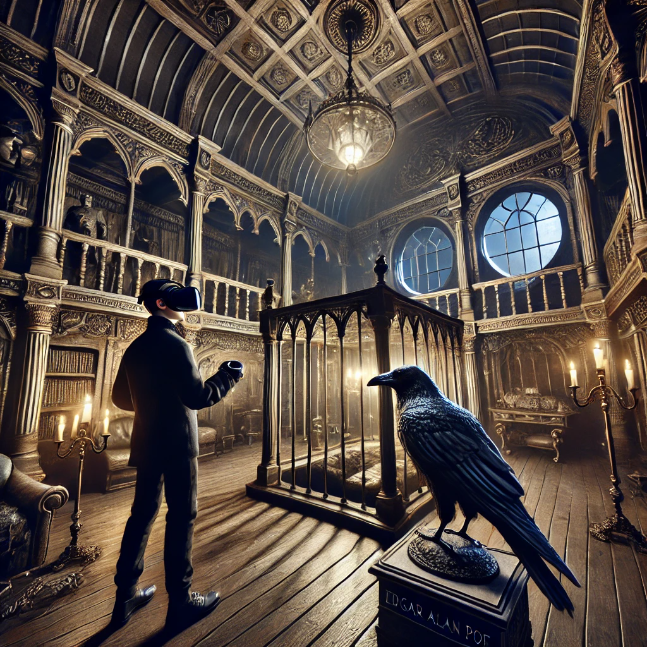The Raven VR; by Edgar Allan Poe: A Virtual Reality (VR) Experience

Edgar Allan Poe's "The Raven" is a cornerstone of American literature, celebrated for its haunting atmosphere and melancholic themes. This classic poem has captivated readers for generations with its dark, atmospheric storytelling. Today, technology has given "The Raven" a new life through Virtual Reality (VR), allowing users to experience the poem in an immersive and interactive environment. This article delves into the VR adaptation of "The Raven," exploring its features, the technology behind it, and its impact on literature and storytelling.
The Original "The Raven"
Background and Significance
First published in 1845, "The Raven" is one of Edgar Allan Poe's most famous works. The poem tells the story of a grieving man visited by a mysterious raven, whose repeated utterance of "Nevermore" drives the narrator to despair. "The Raven" is renowned for its musicality, stylized language, and supernatural ambiance, making it a quintessential example of Gothic literature.
Literary Elements
- Meter and Rhyme: Poe's use of trochaic octameter and a consistent rhyme scheme gives the poem its rhythmic quality.
- Symbolism: The raven symbolizes death and the narrator's inability to escape his sorrow.
- Mood: The dark and eerie mood is created through Poe's choice of words and the poem's setting in a shadowy chamber at midnight.
The VR Experience of "The Raven"
Introduction to the VR Adaptation
"The Raven VR" is an immersive adaptation of Edgar Allan Poe's classic poem, available on platforms like Oculus Rift and HTC Vive. This VR experience brings the haunting world of "The Raven" to life, allowing users to step into the poem's setting and interact with its elements.
Features of the VR Experience
- Immersive Environment: Users can explore the narrator's chamber, with its detailed Gothic decor and dim lighting that enhance the eerie atmosphere.
- Interactive Elements: The VR experience includes interactive features such as opening doors, examining objects, and watching the raven move around the room.
- Narration and Sound: The poem is recited by a voice actor, accompanied by ambient sounds and music that heighten the sense of dread and suspense.
Technology Behind the VR Experience
- 3D Modeling: Advanced 3D modeling techniques were used to recreate the Gothic setting of the poem, capturing the intricate details of the chamber and its furnishings.
- Motion Tracking: VR platforms utilize motion tracking to allow users to move freely within the virtual space, enhancing the sense of immersion.
- Audio Integration: High-quality audio integration ensures that the poem's narration and accompanying sounds are clear and impactful, adding to the overall experience.
Impact on Literature and Storytelling
Enhanced Engagement
The VR adaptation of "The Raven" offers a unique way to engage with Poe's work. By stepping inside the poem, users can gain a deeper understanding of its themes and atmosphere. This immersive experience brings a new dimension to the poem, making it more accessible and engaging for modern audiences.
Educational Value
The interactive and immersive nature of the VR experience makes it an excellent educational tool. Students can explore the poem's setting and symbolism in a more engaging way than traditional reading methods. This hands-on approach to literature can enhance comprehension and retention of the material.
Accessibility
VR technology makes literature more accessible to a wider audience. People who may struggle with traditional reading methods, such as those with visual impairments or learning disabilities, can experience the poem in a new and engaging way. This democratization of literature access has the potential to inspire a new generation of readers and literary enthusiasts.
User Reviews and Reception
Positive Feedback
Users have praised "The Raven VR" for its attention to detail and the immersive quality of the experience. Many have described it as a transformative way to experience literature, providing insights that are not possible through traditional reading methods.
Criticisms and Challenges
Some users have noted that the VR experience can be disorienting for those not accustomed to virtual environments. Additionally, the technology is still evolving, and there are limitations in terms of resolution and motion tracking that can affect the overall experience.
Conclusion
The VR adaptation of Edgar Allan Poe's "The Raven" represents a significant step forward in the way we experience and appreciate literature. By combining advanced technology with classic poetry, VR experiences like this one offer a deeper, more immersive understanding of literary works. As technology continues to evolve, we can expect even more innovative ways to engage with the world of literature, making it accessible and enjoyable for a global audience.
For more insights into the future of reading with VR and AR, check out our detailed article on Virtual and Augmented Reality (VR/AR) Storytelling and Books: The Future of Reading. Discover how these technologies are shaping the future of books and storytelling.
To learn more about another immersive art experience, visit our article on The Night Cafe" by Vincent van Gogh: A Virtual Reality (VR) Experience.



